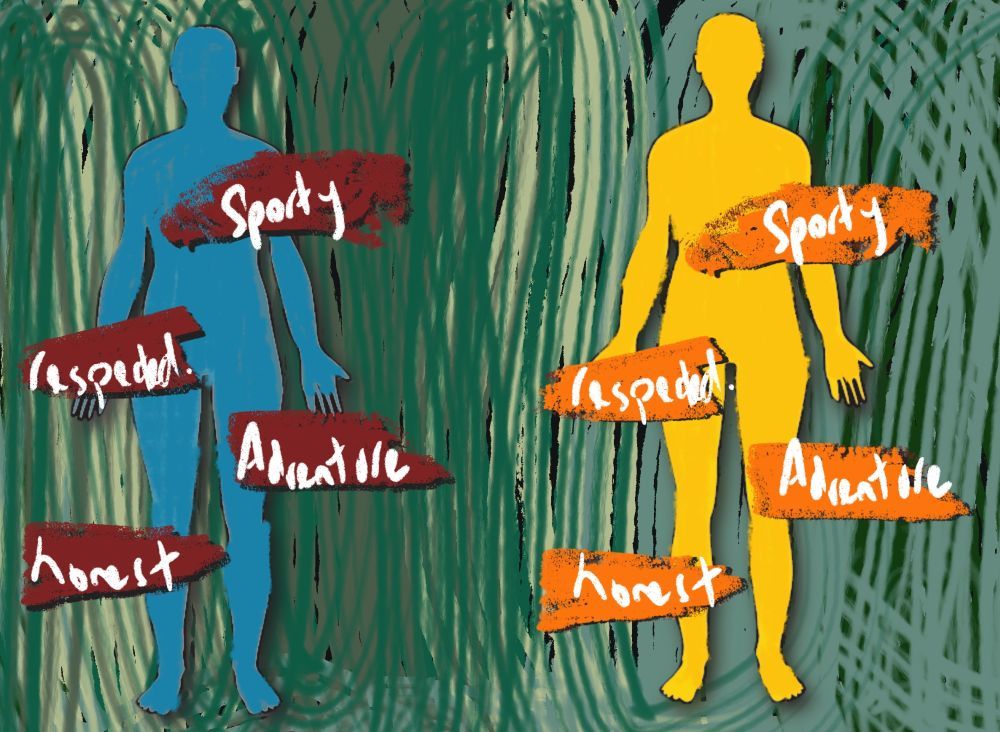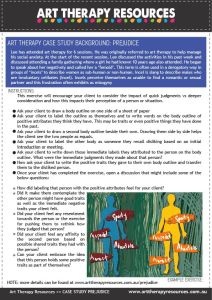THIS POST INCLUDES:
- Art Therapy and Prejudice
- About the Client
- Art Therapy Exercise
- Client Insight and Outcomes
- Disclaimer
- FREE DOWNLOAD Art Therapy Exercise
ART THERAPY AND PREJUDICE
Very few clients will attend therapy with a view to overcoming their personal prejudice. Most people don’t believe they are prejudice and instead believe their views are justified based on their experiences.
While prejudice may not be the presenting issue, it is an issue that may arise in a session. Most therapists are taught about cultural differences and how this may impact a client’s perceptions, however, the focus is typically on how therapists can be inclusive of different cultural values, and not specifically how to work with clients who hold views that are culturally prejudicial.
A THERAPIST’S DILEMMA TO ADDRESS PREJUDICE
It can be difficult for therapists to know how to address these issues of prejudice especially when it is not the primary reason for the client attending therapy.
For many therapists, the foundation of therapy, counseling, and positive mental wellbeing embraces social acceptance of all cultures. When a client presents views that reject social acceptance, it can become a difficult position for the therapist.
On one hand, the therapist understands that clients can hold many personal views that may reject social norms and for the most part, this is based on what the client has been taught to understand about their environment. On the other hand, therapists feel a moral responsibility to uphold the views of cultural acceptance. The question then becomes whether to address the issue of held prejudices with the client or only work with the issues that the client brings to the session.
The therapist is presented with a dilemma and can decide to follow one course over another, however, there may be room to support both points of view where your client is supported, yet you are able to maintain your moral responsibility to your personal and professional ethics.
RESPONDING TO PREJUDICE
The way in which therapists should address prejudice with their clients is rarely a prescriptive exercise as each client will respond differently. Furthermore, each issue of prejudice may require a different approach. For example, you may not address issues of racism the same way you address issues of ageism.
Responding to prejudicial statements in session can often be done in a reactionary way. This is a good reason why therapists may want to consider their approach to how they want to react in session if this occurs. A plan can help therapists take a more considered approach that will result in more effective communication instead of emotional reactions.
WHAT TO DO IN A THERAPY SESSION
- Develop an overall goal of how you want to react. Do you want to explore, discuss, effect change, condemn, or end your therapeutic relationship? These are serious questions to consider. Understand your own motivation when addressing issues of prejudice.
- Take a breath. What you hear from your client may create an immediate reaction of disgust or contempt. To move forward, it will help that you remain calm and focused on your goal of personal growth vs condemnation.
- Consider your own client’s goals for this session. Is your client emotionally stressed or open for discussion?
- Consider your client’s own cultural background and how this might contribute to their held views.
- Consider what function these prejudices are giving your client. Eg. Boosting self-esteem above other classes (classicism), justifying not being in a relationship (sexism).
- Consider the client’s motivation to change held views. Recall past experiences where the client changed their held view.
- Engage with your client based on the concept of motivational interviewing. It is more beneficial to have the client explore their held views through internal questioning as opposed to hearing statements that appear judgment-based. Help the client explore the origins of their beliefs and what purpose it serves for them to maintain these held views.
- Engage in discussion with your client to introduce the concept of empathy and understanding towards other groups of people that are different from your client.
Stereotypes, prejudice, and discrimination all fall within the same process, however, there are subtle differences in each label. Typically one label leads to the next as the belief system becomes more entrenched.
Stereotypes (thoughts) refer to what we think about people (eg. old people are slow), prejudice (emotions) refers to how we feel about people (eg. slow old people make me feel impatient by wasting my time), and discrimination (behaviours) refers to how we act (eg. not hiring older people to work in a retail store based on the belief they are too slow). Stereotypes lead to our prejudices which in turn leads to behaviour of discrimination.
It’s important to remember the different processes that are involved when you witness an act of discrimination compared to when you witness someone expressing a stereotype or prejudice. A behavioural act is something that might require you to take immediate and reactionary action. Examples include if a client is vilifying a staff member due to their race. This behavioural act may require an immediate intercept by you. Conversely, if a client is expressing an attitude of prejudice through conversation in session, then this cognitive and emotional belief held by the client can be challenged in a less immediate manner.
TYPES OF PREJUDICE
Below are some of the commonly held prejudices that are prevalent in society:
- Race
- Gender
- Sexuality
- Disabilities
- Religious
- Ageism
- Classicism
- Nationalism
ABOUT THE CLIENT
- Name: Lee
- Age: 19
CURRENT CLIENT ISSUES:
Lee has attended art therapy for 6 sessions. He was originally referred to art therapy to help manage his social anxiety. At the start of the recent session, Lee discussed the activities in his past week and discussed attending a family gathering where a girl he had known 10 years ago also attended. He began to speak about her negatively and called her a ‘femoid’. This term is often used in a derogatory way in groups of ‘incels’ to describe women as sub-human or non-human. Incel is slang to describe males who are involuntary celibates (incel). Incels perceive themselves as unable to find a romantic or sexual partner and this frustration often exhibits as misogyny.
ART THERAPY EXERCISE
Often we make quick judgments about people and situations without carefully considering the fuller picture of both the person and the basis of our own perceptions. This exercise will encourage your client to consider the impact of quick judgments vs deeper consideration and how this impacts their perception of a person or situation.
INSTRUCTIONS:
- Ask your client to draw a body outline on one side of a sheet of paper
- Ask your client to label the outline as themselves and to write words on the body outline of positive attributes they think they have. This may be traits or even positive things they have done in the past.
- Ask your client to draw a second body outline beside their own. Drawing them side by side helps the client see the two people as equals.
- Ask your client to label the other body as someone they recall disliking based on an initial introduction or meeting.
- Ask your client to write down those immediate labels they attributed to the person on the body outline. What were the immediate judgments they made about that person?
- Now ask your client to write the positive traits they gave to their own body outline and transfer them to the disliked person.
- Once your client has completed the exercise, open a discussion that might include some of the below questions:
- How did labeling that person with the positive attributes feel for your client?
- Did it make them contemplate the other person might have good traits as well as the immediate negative traits your client felt?
- Did your client feel any resentment towards the person or the exercise for pushing them to rethink how they judged that person?
- Did your client feel any affinity to the second person based on possible shared traits they had with the person?
- Can your client embrace the idea that this person holds some positive traits as part of themselves?
CLIENT INSIGHT AND OUTCOMES
Lee saw that his description of his old friend as judgmental. From the exercise, Lee could see that his quick judgment caused a negative emotional reaction from himself and he lashed out by labeling his old friend with a derogatory term despite not knowing her at all.
Lee and his therapist continued to discuss other instances where Lee has been quick to judgment based on a comment made by someone else. Lee started to see a pattern in how he interpreted many comments made to him as negative statements about himself.

DISCLAIMER
This case study represents a snapshot of the client’s progress in treatment. The exercise in this article could be used as written or as a guide for new and original tasks developed by the Art Therapist. Responsibility for treatment resides with the individual therapist who understands their clients specific needs. The art therapy exercise should not be viewed as a pre-defined directive on how to treat a client that presents with a specific range of problems.This art therapy exercise will help build a database of knowledge to draw upon when helping your client. Art Therapy is associated with psychotherapy techniques, however each therapist often approaches therapy with their own foundation of psychological interventions, whether it be psychotherapy, CBT, DBT or other methods.
FREE DOWNLOAD: Art Therapy Exercise
Download the FREE Art Therapy Exercise based on the above Case Study. The free download includes instructions for the art therapy exercise, along with an example of the art therapy exercise.

BUILD YOUR ART THERAPY REFERENCE MATERIALS:
Pin this image to your Pinterest board.

SHARE KNOWLEDGE & PASS IT ON:
If you’ve enjoyed this post, please share it on Facebook, Twitter, Pinterest. Thank you!
